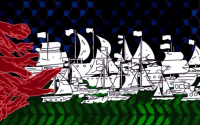13 October 2005The Independent
The native hunters had launched their small boats before first light, pushing off on the becalmed Arctic Ocean in search of a quarry their ancestors had pursued for centuries. Within hours, they had found and killed the 30ft whale, towed it five miles back to shore, and dragged its vast, gleaming body on to the gravel of the beach. Now they were butchering it by hand.
It was an extraordinary, blood-splattered sight. Dozens of people were cutting away the thick, white blubber, joyously hacking at the deep, dark-red whale-meat, smiling and laughing as they sliced off the most sought-after pieces for later. There was nothing disrespectful about their pleasure; it was rather, a celebration of the knowledge that the community would share this calorie-rich bounty in the freezing months of the coming winter. "It's to feed our people,"said Ray Patkotak, 39, the co-captain of the crew that caught the whale (he shares the leadership with his father Simeon). "It's what we love to eat and that helps us in the winter."
Though the Inupiat people of Alaska and northern Canada have been hunting the whale for more than a millennium, this tradition may be threatened. Senior members of the community say so-called "aboriginal" whalers such as themselves are being used in a political battle fought by nations such as Japan, the US and Britain over the future of whaling. At worst, they fear the International Whaling Commission could try to ban them hunting whales. That would mean the end of a way of life that has lasted at least 1,200 years.
"It's our culture," said Mr Patkotak, his hands and clothes smeared with blood and pungent blubber. "From time immemorial we have hunted the bowhead whales. It's about sharing with the community."
The IWC agreement has assigned a total shared quota of 280 whales to more than a dozen native communities in North America over a five-year period that ends this year. This week, The Independent had the rare opportunity to witness the hunt and speak to the hunters in the remote coastal town of Barrow, the most northerly community in the United States, 300 miles inside the Arctic Circle.
Like the other native communities in the Arctic, Barrow is struggling with change. Amid this barren, treeless landscape of flat, endless horizons there are problems of alcoholism, drugs and unemployment. The growth of the offshore oil and gas industry to the east on Prudhoe Bay and its vast wealth of energy stocks brought considerable financial benefits to some of these communities but it has also sped growth and put pressure on the traditional culture.
But the hunting of the bowhead whale by the Inupiat remains precisely calibrated by custom and tradition. Twice a year, the hunters will set out - traditionally men, but in these changing times women will go as well - to hunt for whales using hand-thrown harpoons. In the Arctic spring, the hunters use hand-made skin boats which they carry across the sea-ice to open water then paddle after the migrating whales. In winter, they use small metal boats and outboard motors as they search for the whales, then moving in the other direction.
And some of their hand-thrown harpoons may be several hundred years old. In newer one, the head contains a small explosive charge which detonates when the point is driven deep into the whale. A practised and experienced hunter knows exactly where he must strike for a clean kill but it is the job of the tiller-man to ensure the small, fragile boat is brought alongside the powerful whale, some 80ft long. Hunting the whale is a rite of passage for the younger members of the community; it is not for the faint-hearted.
"The hardest thing is getting close to the whale," said Carl Kippi, the harpooner, who - according to custom - was given one of the front flippers. "The tiller-man has the hardest job. You have to be in the right place. [The whale] can turn the boat over." The whales hunted by the Inupiat is Balaena mysticetus, or bowhead. This was the creature, whose massive head can account for a third of its entire length, that was the prize sought by the early commercial whale-hunters from Britain who set out from Hull or Peterhead.
They hunted the bowhead - or Greenland right whale, as it was then known - for its blubber, which can be an astonishing 2ft thick. No other whale has such a high ratio of blubber to body mass, something that was not lost on the whale-hunters seeking fuel for lamps.
Barry Lopez, in his book Arctic Dreams, estimates that the blubber from a good-sized whale would provide up to 25 tons of oil, and its baleen plates - the black mouth "feathers" that capture and siphon the krill and plankton on which it feeds - would provide more than a ton of whalebone. The baleen was used to make corsets, umbrellas and venetian blinds, window gratings and furniture.
These hunters severely depleted the population of the bowhead and even today the US Fish and Wildlife Service lists the species as "endangered". Precisely how many bowhead remain is unknown but experts believe, with some confidence, they say, that there are 10,000, increasing by 3.5 per cent a year. "The estimated rate of increase and the fact that the number of calves counted in 2001 is the highest ever recorded suggest a steady recovery of this population," said Craig George, a biologist with the North Slope Borough, the world's largest municipal authority that covers Barrow and a further 77,000 square miles of northern Alaska. There is a broad scientific consensus that the bowhead population can easily sustain an annual harvest of 60 animals, yet the Inupiat say they are facing intense pressure from Japan, which wishes to resume commercial whale-hunting. When the IWC met in Japan in 2002, the Japanese delegation refused to agree to new quotas for aboriginal whale-hunters.
Eventually, after a three-month hiatus, the Japanese agreed, but only after obtaining a undertaking from the US authorities that it could prove the bowhead hunted by the Inupiat were not a genetically distinct and less robust sub-group of the larger population. The US is spending millions of dollars to conduct this research and provide the data to Japan by the time the quota ends. Britain supports limited whaling by the Inupiat, having accepted their "subsistence needs" but it is adamantly opposed to the resumption of commercial hunting by Japan.
A spokeswoman for the Department of Environment, Food and Rural Affairs (Defra), said: "Even if agreement were reached on a robust, revised management scheme to control commercial whaling such that catch limits were never exceeded, and Japan were offering to trade cessation of scientific whaling off against a commercial quota, the UK would probably not wish to be seen to support the resumption of commercial whaling."
The Inupiat hunters of Barrow - so far north that in mid-winter there are 67 consecutive days when the sun does not rise - fear they have become "pawns" in a broader dispute focused on Japan's whaling ambitions. They draw a clear distinction between subsistence hunting, which feeds an entire community, and commercial whaling that could result in hundreds or even thousands of whales being killed.
Norway, the one country the IWC says that still operates a commercial hunt despite IWC objections - last year killed 544 minke whales. This year, their target was 796.
Simeon Patkotak, the well-weathered other co-captain, looked up at the hungry, screaming seabirds wheeling low overhead as the whale was butchered. "It's politics," he said. Since the 1970s, Mr Patkotak has been at whaling meetings around the world and he has much experience of the politics. Though 73, that morning he had been among the crew hunting the bowhead. "I like to travel and I like to hunt whales," he said with a smile. "I eat a lot of raw food."
Just as there are customs about the hunting of the whale, there are equally strong traditions about how it is divided. The tavsi, a 12in ring around the belt of the animal, is set aside for the captain of the boat; the ningiq, the area from below the belly-button to the tail of the whale, is divided among the boats who helped tow the whale to the shore and the people who helped butcher it. The uati, upper torso, is set aside for celebration feasts.
When the whale is killed, the women in the boat captain's house will work through the night cooking parts of the whale and the next day a flag will be flown from the house, an invitation to anyone to come and share the prepared food.
The evening the whale was butchered, The Independent was invited to dinner at the home of Patricia Aamadt, an Inupiat woman married to a Norwegian-American who has lived in Alaska for more than 40 years. Mrs Aamadt had spent much of her childhood in Barrow, studied at Harvard University, and returned to be school superintendent. She combined the ability to run a Western-style education administration with the know-how to sew traditional parkas from caribou skin and to cut up and prepare wild animals ranging from walrus to Arctic fox.
That evening, she prepared a meal of whale meat stir-fried with pieces of the blubber and skin, a mixture that somehow tasted both gamey and fishy. She also prepared pieces of blubber and skin, or muktuk, that had been simply boiled.
The latter is considered a delicacy, though not as much as mimakiaq, a fearful-sounding combination of whale-meat, blubber, blood and pieces of tongue stirred together in a bucket and left to ferment. One local woman told me it was ready to eat when it started to bubble.
Like many other Inupiat in Barrow, Mrs Aamadt said the twice-yearly whale hunt fulfilled an important tradition, a culture-affirming endeavour that remained at the heart of the native community here and elsewhere in Alaska. But she insisted that it was historically also an essential way of providing food to the people. "We so look forward to this time of year," she said.
That night, walking back through the dark freezing streets of Barrow, the communal nature of the whale hunt was plain to see. Pick-up trucks were stopping off at what seemed like every other house, delivering a share of the kill. Young men would walk inside with bags containing chunks of meat and pieces of blubber taken that very afternoon from the whale. Everyone looked very happy.






